Management Accounting Report: Costing and Value Chain Analysis
VerifiedAdded on 2023/01/18
|15
|2210
|39
Report
AI Summary
This comprehensive management accounting report delves into various aspects of financial analysis and cost management. It begins with an in-depth examination of value chains, specifically analyzing Wesfarmers' value chain, identifying primary and secondary activities, and discussing associated management accounting challenges. The report then proceeds to detailed cost accounting exercises, including the preparation of a cost of goods manufactured statement, a cost of sales statement, and an income statement for Portland Precision Engineering Company. Furthermore, it explores cost allocation methods, comparing and contrasting the direct, step-down, and reciprocal methods, and providing a justification for the most accurate approach. The report continues with a discussion on job costing and process costing methods, including the application of weighted average and FIFO methods in process costing, providing a complete overview of cost accounting principles and practices.

Running head: MANAGEMENT ACCOUNTING
Management Accounting
Name of the Student
Name of the University
Author’s Note
Management Accounting
Name of the Student
Name of the University
Author’s Note
Paraphrase This Document
Need a fresh take? Get an instant paraphrase of this document with our AI Paraphraser

1MANAGEMENT ACCOUNTING
Table of Contents
Answer to Question 1: Value Chains.........................................................................................3
1.1 Introduction......................................................................................................................3
1.2 Value Chain of Wesfarmers.............................................................................................3
1.2.1 Primary Activities.....................................................................................................3
1.2.2 Secondary Activities.................................................................................................4
1.3 Conclusion........................................................................................................................5
Answer to Question 2: Cost Manufacturing Statement..............................................................5
Requirement [1].....................................................................................................................5
Requirement [2].....................................................................................................................6
Requirement [3] and [4].........................................................................................................6
Answer to Question 3: Cost Allocation.....................................................................................7
Requirement [1].....................................................................................................................7
Requirement [2].....................................................................................................................7
Requirement [3].....................................................................................................................7
Requirement [4].....................................................................................................................7
Requirement [5].....................................................................................................................8
Requirement [6].....................................................................................................................8
Requirement [7].....................................................................................................................9
Answer to Question 4: Job Costing..........................................................................................11
Requirement [1]...................................................................................................................11
Table of Contents
Answer to Question 1: Value Chains.........................................................................................3
1.1 Introduction......................................................................................................................3
1.2 Value Chain of Wesfarmers.............................................................................................3
1.2.1 Primary Activities.....................................................................................................3
1.2.2 Secondary Activities.................................................................................................4
1.3 Conclusion........................................................................................................................5
Answer to Question 2: Cost Manufacturing Statement..............................................................5
Requirement [1].....................................................................................................................5
Requirement [2].....................................................................................................................6
Requirement [3] and [4].........................................................................................................6
Answer to Question 3: Cost Allocation.....................................................................................7
Requirement [1].....................................................................................................................7
Requirement [2].....................................................................................................................7
Requirement [3].....................................................................................................................7
Requirement [4].....................................................................................................................7
Requirement [5].....................................................................................................................8
Requirement [6].....................................................................................................................8
Requirement [7].....................................................................................................................9
Answer to Question 4: Job Costing..........................................................................................11
Requirement [1]...................................................................................................................11
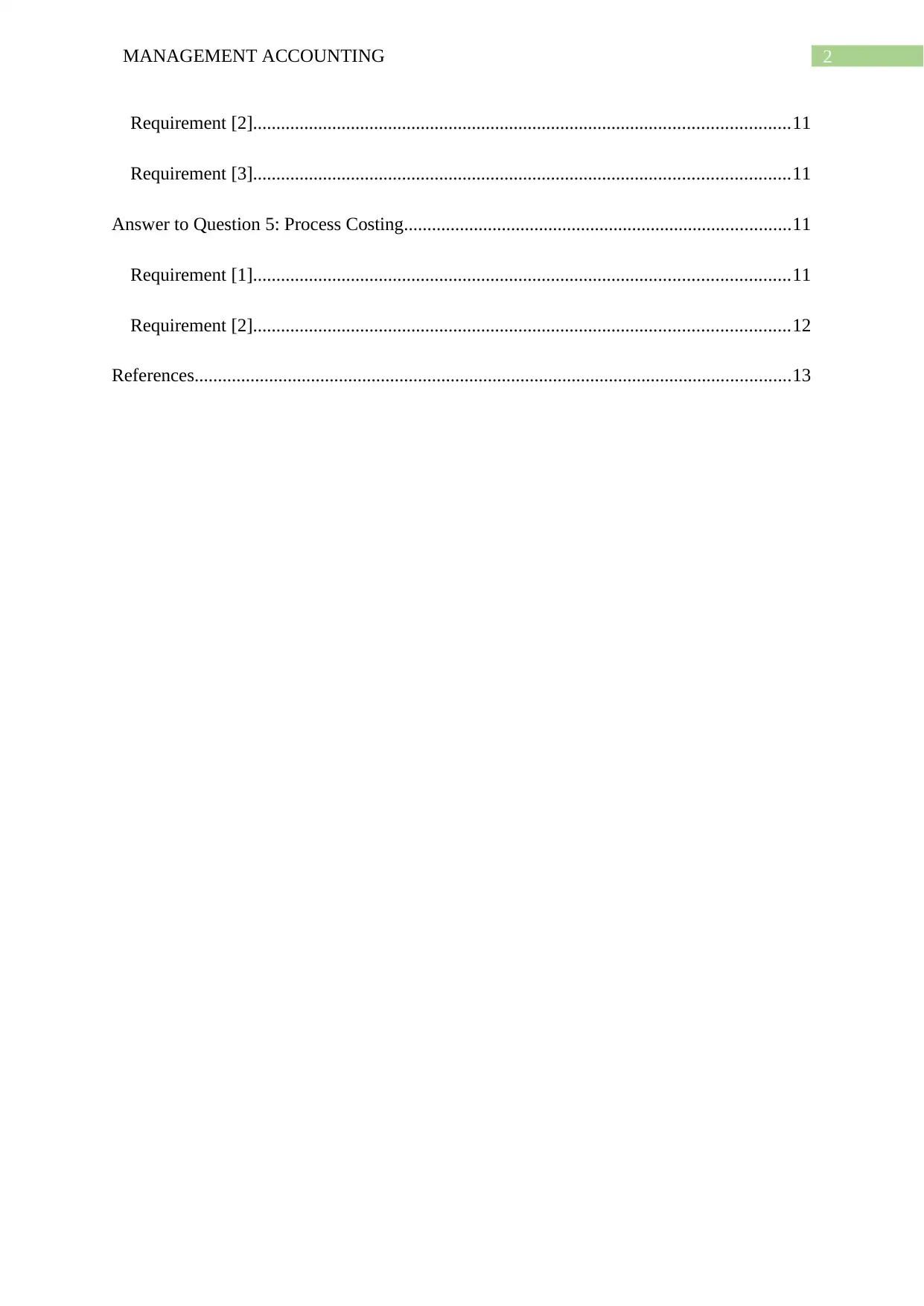
2MANAGEMENT ACCOUNTING
Requirement [2]...................................................................................................................11
Requirement [3]...................................................................................................................11
Answer to Question 5: Process Costing...................................................................................11
Requirement [1]...................................................................................................................11
Requirement [2]...................................................................................................................12
References................................................................................................................................13
Requirement [2]...................................................................................................................11
Requirement [3]...................................................................................................................11
Answer to Question 5: Process Costing...................................................................................11
Requirement [1]...................................................................................................................11
Requirement [2]...................................................................................................................12
References................................................................................................................................13
⊘ This is a preview!⊘
Do you want full access?
Subscribe today to unlock all pages.

Trusted by 1+ million students worldwide

3MANAGEMENT ACCOUNTING
Answer to Question 1: Value Chains
1.1 Introduction
Value chain is considered as a set of activities perfumed by a specific firm with the
aim to deliver valuable products and services to the customers (Mudambi & Puck, 2016). The
main aim of this report is the analysis of the value chain of Wesfarmers Limited
(Wesfarmers).
1.2 Value Chain of Wesfarmers
In the recent years, Wesfarmers is facing certain management accounting issues in
relation to the value chain. Some of the issues in Wesfarmers are lose in the vision as well as
overall strategy through dividing their operations into various activities, difficulties in
segregating the primary and supporting activities as a result of increased complexity, gaining
required accounting information due to the division in different processes and others. In order
to overcome these management accounting related difficulties, Wesfarmers has upgraded
their value chain (Koc & Bozdag, 2017). The following discussion shows the main
components of the value chain of Wesfarmers.
According to Porter’s Value Chain model, Wesfarmers has segregated their value
chain in two activities; they are Primary Activities and Secondary Activities.
1.2.1 Primary Activities
The primary value chain activities of Wesfarmers have direct involvement with the
production and selling products. The primary activities are:
Inbound Logistics – Wesfarmers maintain strong relationship with their suppliers to gain
their support for receiving, storing and distributing products (Mohajeri et al., 2014).
Answer to Question 1: Value Chains
1.1 Introduction
Value chain is considered as a set of activities perfumed by a specific firm with the
aim to deliver valuable products and services to the customers (Mudambi & Puck, 2016). The
main aim of this report is the analysis of the value chain of Wesfarmers Limited
(Wesfarmers).
1.2 Value Chain of Wesfarmers
In the recent years, Wesfarmers is facing certain management accounting issues in
relation to the value chain. Some of the issues in Wesfarmers are lose in the vision as well as
overall strategy through dividing their operations into various activities, difficulties in
segregating the primary and supporting activities as a result of increased complexity, gaining
required accounting information due to the division in different processes and others. In order
to overcome these management accounting related difficulties, Wesfarmers has upgraded
their value chain (Koc & Bozdag, 2017). The following discussion shows the main
components of the value chain of Wesfarmers.
According to Porter’s Value Chain model, Wesfarmers has segregated their value
chain in two activities; they are Primary Activities and Secondary Activities.
1.2.1 Primary Activities
The primary value chain activities of Wesfarmers have direct involvement with the
production and selling products. The primary activities are:
Inbound Logistics – Wesfarmers maintain strong relationship with their suppliers to gain
their support for receiving, storing and distributing products (Mohajeri et al., 2014).
Paraphrase This Document
Need a fresh take? Get an instant paraphrase of this document with our AI Paraphraser

4MANAGEMENT ACCOUNTING
Operations – Wesfarmers has implemented effective processes for processing the raw
materials into the end products so that they can be launched to the market.
Outbound Logistics – Wesfarmers has implement outbound logistics services like material
handling, warehousing, scheduling, order processing, transporting and delivering to the
destinations (Mohajeri et al., 2014).
Marketing and Sales – Under this activity, Wesfarmers has taken initiatives like developing
sales-force, advertising, pricing, promotional activities, relationship development with the
customers, competitor analysis and others (Mohajeri et al., 2014).
Services – Wesfarmers has ensured the introduction of both the pre-sale and post-sales
services to their customers with the aim to cater to their needs in better manner.
1.2.2 Secondary Activities
These activities play a crucial role in providing support to these primary activities and
these activities of Wesfarmers are shown below:
Infrastructure – Wesfarmers has introduced system like quality management, handling of
legal matters, financial planning, accounting and strategic management. These activities help
Wesfarmers in optimising the whole value chain (Sivula & Kantola, 2014).
Human Resource Management – Wesfarmers has considered the evaluation of certain
human resource aspects like recruiting, selecting, training, rewarding, performance
management and others (Sivula & Kantola, 2014).
Technology Development – Wesfarmers has introduced certain services like automation
software, technology-driven customer care, product design research and others.
Operations – Wesfarmers has implemented effective processes for processing the raw
materials into the end products so that they can be launched to the market.
Outbound Logistics – Wesfarmers has implement outbound logistics services like material
handling, warehousing, scheduling, order processing, transporting and delivering to the
destinations (Mohajeri et al., 2014).
Marketing and Sales – Under this activity, Wesfarmers has taken initiatives like developing
sales-force, advertising, pricing, promotional activities, relationship development with the
customers, competitor analysis and others (Mohajeri et al., 2014).
Services – Wesfarmers has ensured the introduction of both the pre-sale and post-sales
services to their customers with the aim to cater to their needs in better manner.
1.2.2 Secondary Activities
These activities play a crucial role in providing support to these primary activities and
these activities of Wesfarmers are shown below:
Infrastructure – Wesfarmers has introduced system like quality management, handling of
legal matters, financial planning, accounting and strategic management. These activities help
Wesfarmers in optimising the whole value chain (Sivula & Kantola, 2014).
Human Resource Management – Wesfarmers has considered the evaluation of certain
human resource aspects like recruiting, selecting, training, rewarding, performance
management and others (Sivula & Kantola, 2014).
Technology Development – Wesfarmers has introduced certain services like automation
software, technology-driven customer care, product design research and others.
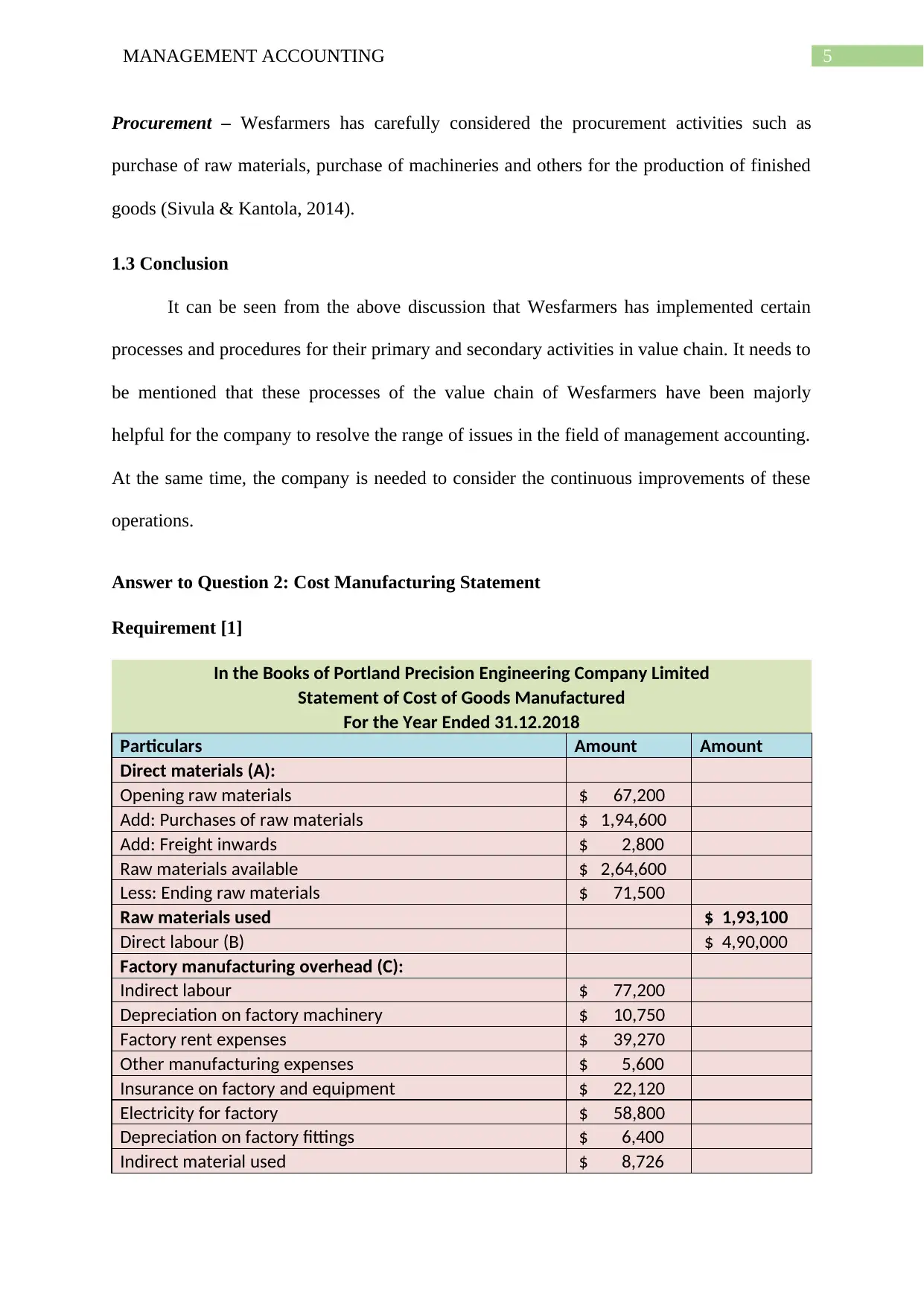
5MANAGEMENT ACCOUNTING
Procurement – Wesfarmers has carefully considered the procurement activities such as
purchase of raw materials, purchase of machineries and others for the production of finished
goods (Sivula & Kantola, 2014).
1.3 Conclusion
It can be seen from the above discussion that Wesfarmers has implemented certain
processes and procedures for their primary and secondary activities in value chain. It needs to
be mentioned that these processes of the value chain of Wesfarmers have been majorly
helpful for the company to resolve the range of issues in the field of management accounting.
At the same time, the company is needed to consider the continuous improvements of these
operations.
Answer to Question 2: Cost Manufacturing Statement
Requirement [1]
In the Books of Portland Precision Engineering Company Limited
Statement of Cost of Goods Manufactured
For the Year Ended 31.12.2018
Particulars Amount Amount
Direct materials (A):
Opening raw materials $ 67,200
Add: Purchases of raw materials $ 1,94,600
Add: Freight inwards $ 2,800
Raw materials available $ 2,64,600
Less: Ending raw materials $ 71,500
Raw materials used $ 1,93,100
Direct labour (B) $ 4,90,000
Factory manufacturing overhead (C):
Indirect labour $ 77,200
Depreciation on factory machinery $ 10,750
Factory rent expenses $ 39,270
Other manufacturing expenses $ 5,600
Insurance on factory and equipment $ 22,120
Electricity for factory $ 58,800
Depreciation on factory fittings $ 6,400
Indirect material used $ 8,726
Procurement – Wesfarmers has carefully considered the procurement activities such as
purchase of raw materials, purchase of machineries and others for the production of finished
goods (Sivula & Kantola, 2014).
1.3 Conclusion
It can be seen from the above discussion that Wesfarmers has implemented certain
processes and procedures for their primary and secondary activities in value chain. It needs to
be mentioned that these processes of the value chain of Wesfarmers have been majorly
helpful for the company to resolve the range of issues in the field of management accounting.
At the same time, the company is needed to consider the continuous improvements of these
operations.
Answer to Question 2: Cost Manufacturing Statement
Requirement [1]
In the Books of Portland Precision Engineering Company Limited
Statement of Cost of Goods Manufactured
For the Year Ended 31.12.2018
Particulars Amount Amount
Direct materials (A):
Opening raw materials $ 67,200
Add: Purchases of raw materials $ 1,94,600
Add: Freight inwards $ 2,800
Raw materials available $ 2,64,600
Less: Ending raw materials $ 71,500
Raw materials used $ 1,93,100
Direct labour (B) $ 4,90,000
Factory manufacturing overhead (C):
Indirect labour $ 77,200
Depreciation on factory machinery $ 10,750
Factory rent expenses $ 39,270
Other manufacturing expenses $ 5,600
Insurance on factory and equipment $ 22,120
Electricity for factory $ 58,800
Depreciation on factory fittings $ 6,400
Indirect material used $ 8,726
⊘ This is a preview!⊘
Do you want full access?
Subscribe today to unlock all pages.

Trusted by 1+ million students worldwide
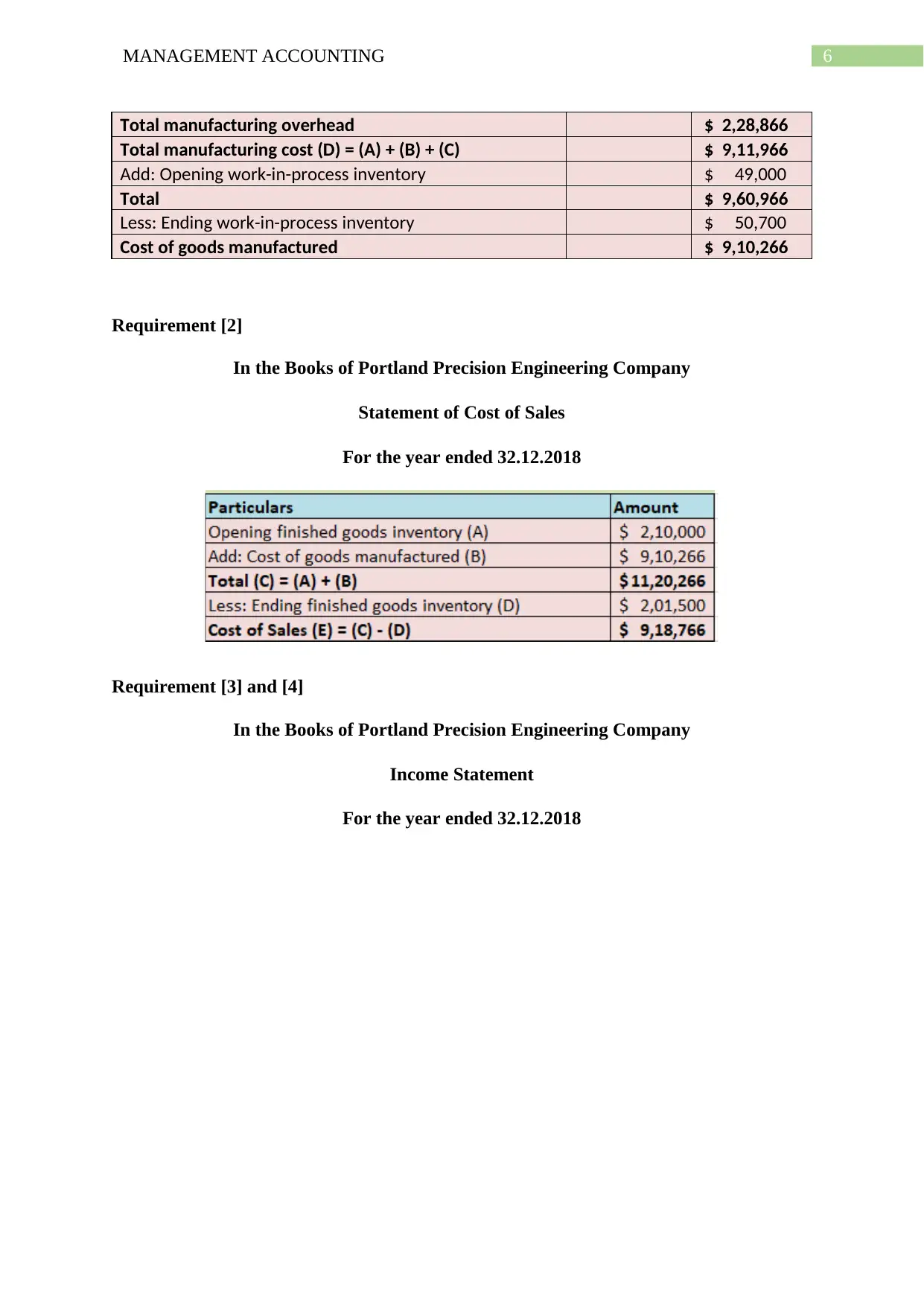
6MANAGEMENT ACCOUNTING
Total manufacturing overhead $ 2,28,866
Total manufacturing cost (D) = (A) + (B) + (C) $ 9,11,966
Add: Opening work-in-process inventory $ 49,000
Total $ 9,60,966
Less: Ending work-in-process inventory $ 50,700
Cost of goods manufactured $ 9,10,266
Requirement [2]
In the Books of Portland Precision Engineering Company
Statement of Cost of Sales
For the year ended 32.12.2018
Requirement [3] and [4]
In the Books of Portland Precision Engineering Company
Income Statement
For the year ended 32.12.2018
Total manufacturing overhead $ 2,28,866
Total manufacturing cost (D) = (A) + (B) + (C) $ 9,11,966
Add: Opening work-in-process inventory $ 49,000
Total $ 9,60,966
Less: Ending work-in-process inventory $ 50,700
Cost of goods manufactured $ 9,10,266
Requirement [2]
In the Books of Portland Precision Engineering Company
Statement of Cost of Sales
For the year ended 32.12.2018
Requirement [3] and [4]
In the Books of Portland Precision Engineering Company
Income Statement
For the year ended 32.12.2018
Paraphrase This Document
Need a fresh take? Get an instant paraphrase of this document with our AI Paraphraser
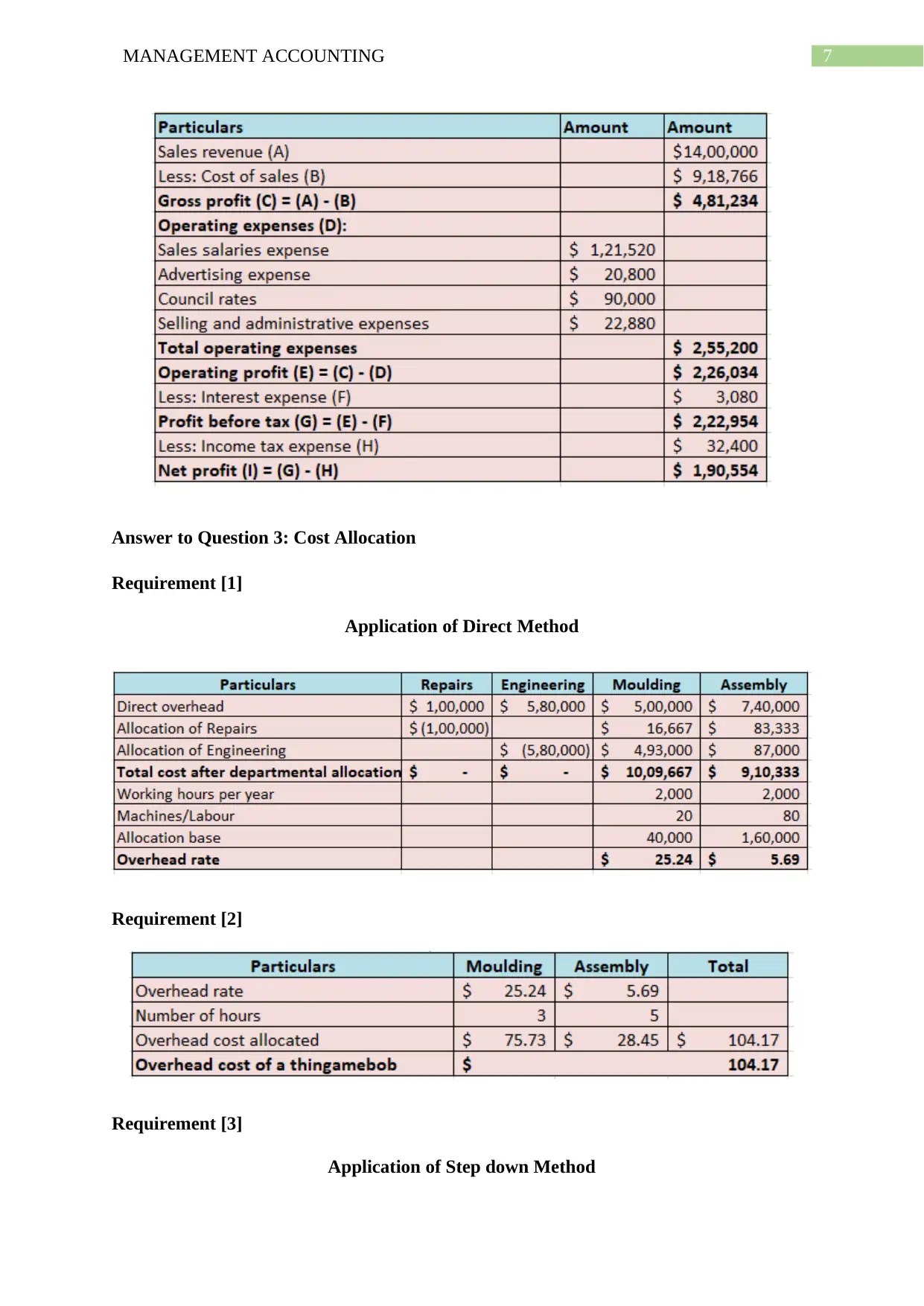
7MANAGEMENT ACCOUNTING
Answer to Question 3: Cost Allocation
Requirement [1]
Application of Direct Method
Requirement [2]
Requirement [3]
Application of Step down Method
Answer to Question 3: Cost Allocation
Requirement [1]
Application of Direct Method
Requirement [2]
Requirement [3]
Application of Step down Method
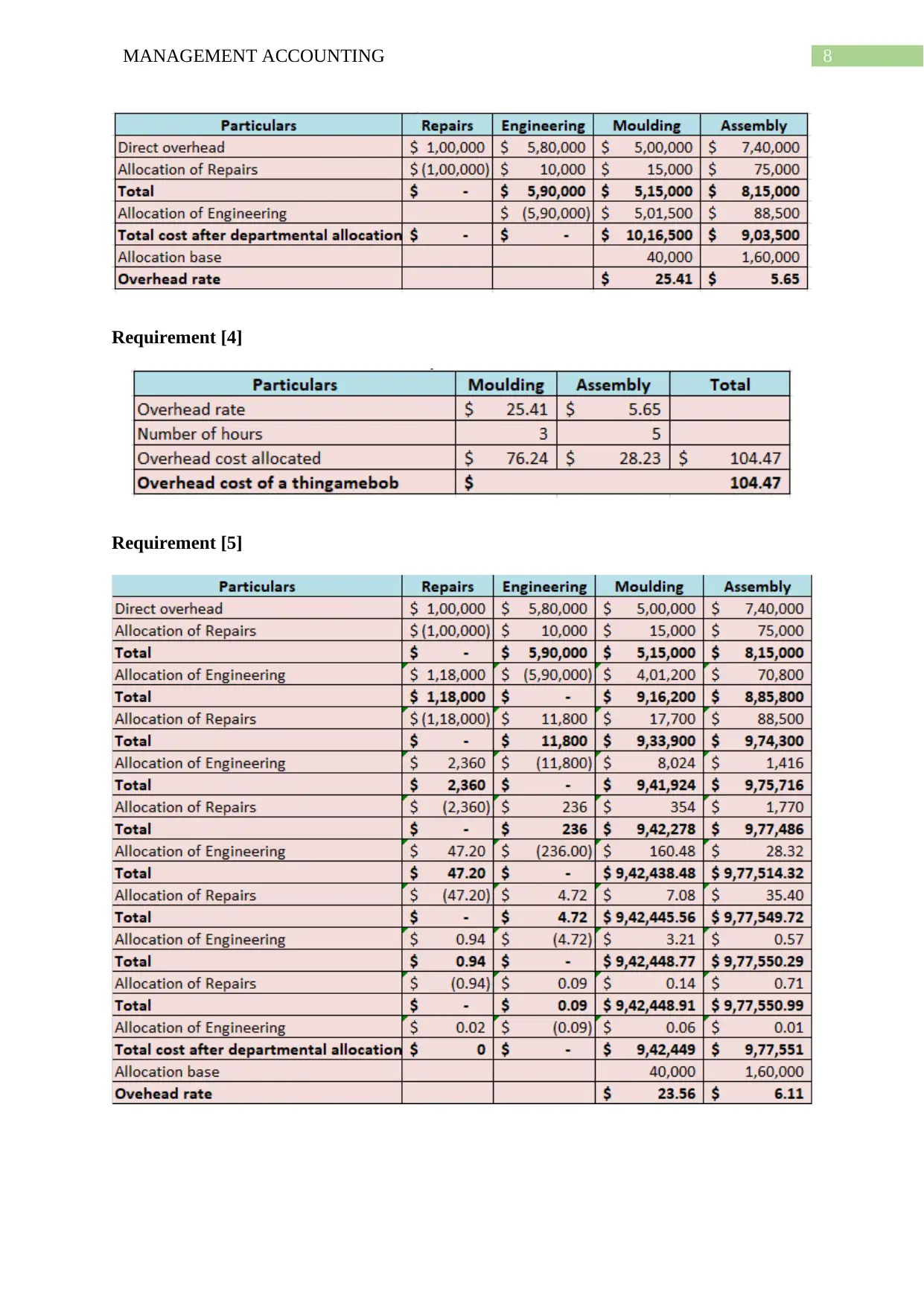
8MANAGEMENT ACCOUNTING
Requirement [4]
Requirement [5]
Requirement [4]
Requirement [5]
⊘ This is a preview!⊘
Do you want full access?
Subscribe today to unlock all pages.

Trusted by 1+ million students worldwide
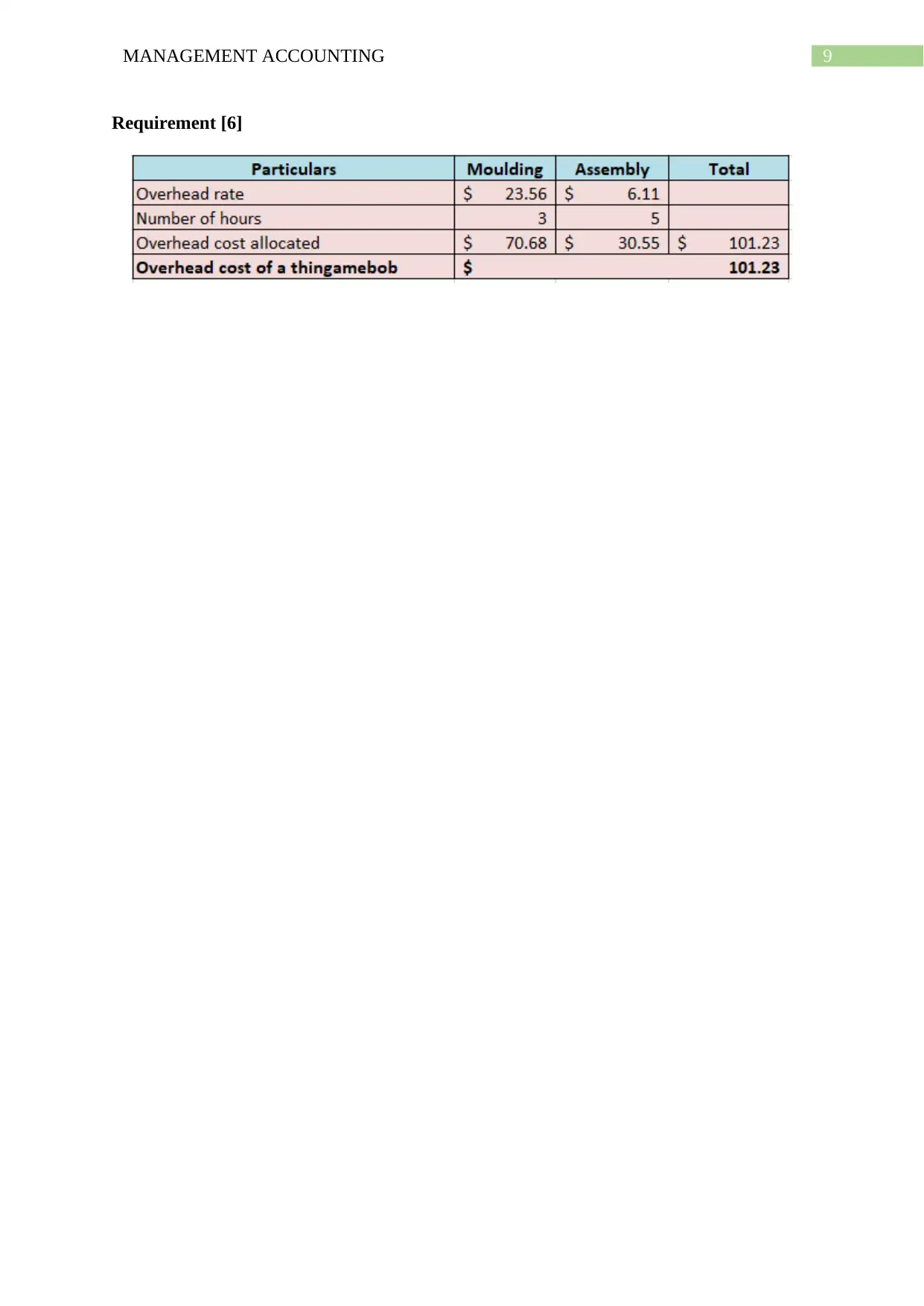
9MANAGEMENT ACCOUNTING
Requirement [6]
Requirement [6]
Paraphrase This Document
Need a fresh take? Get an instant paraphrase of this document with our AI Paraphraser

10MANAGEMENT ACCOUNTING
Requirement [7]
Memo
TO: The Chief Financial Officer
FROM: David Jones
DATE: 10.04.2019
SUBJECT: Explanation on the most accurate method to support departmental cost allocation
The main intention behind writing this internal memo is to provide the Chief Financial
Officer with the suggestion on the fact that which method is the most appropriate for the
process of departmental cost allocation for determining the most accurate overhead rates and
product cost. The following discussion considers the analysis of three methods; they are
Direct method, Step-down method and Reciprocal method.
The direct method is considered as the simplest method among these three methods and the
level of complexity is less in this method (Drury, 2013). Under this method, the accountants
of the companies are needed to assign the costs of each services to each operating department
on the basis of the share of each department and the accountants are needed to consider the
allocation base in this case. One major aspect in this method is that this method does not
provide the accountants with the scope to consider the services used by the other service
departments (Drury, 2013). This method is not used for tackling the complex costing
situations of the companies.
The Step-down method is different from the above discussed direct method in the presence of
certain aspects. Under this particular method, the accountants are needed to consider
assigning costs to each of the service departments on the sequential basis (Kieso, Weygandt
& Warfield, 2016). The commencement of these sequences can be seen with the service
Requirement [7]
Memo
TO: The Chief Financial Officer
FROM: David Jones
DATE: 10.04.2019
SUBJECT: Explanation on the most accurate method to support departmental cost allocation
The main intention behind writing this internal memo is to provide the Chief Financial
Officer with the suggestion on the fact that which method is the most appropriate for the
process of departmental cost allocation for determining the most accurate overhead rates and
product cost. The following discussion considers the analysis of three methods; they are
Direct method, Step-down method and Reciprocal method.
The direct method is considered as the simplest method among these three methods and the
level of complexity is less in this method (Drury, 2013). Under this method, the accountants
of the companies are needed to assign the costs of each services to each operating department
on the basis of the share of each department and the accountants are needed to consider the
allocation base in this case. One major aspect in this method is that this method does not
provide the accountants with the scope to consider the services used by the other service
departments (Drury, 2013). This method is not used for tackling the complex costing
situations of the companies.
The Step-down method is different from the above discussed direct method in the presence of
certain aspects. Under this particular method, the accountants are needed to consider
assigning costs to each of the service departments on the sequential basis (Kieso, Weygandt
& Warfield, 2016). The commencement of these sequences can be seen with the service
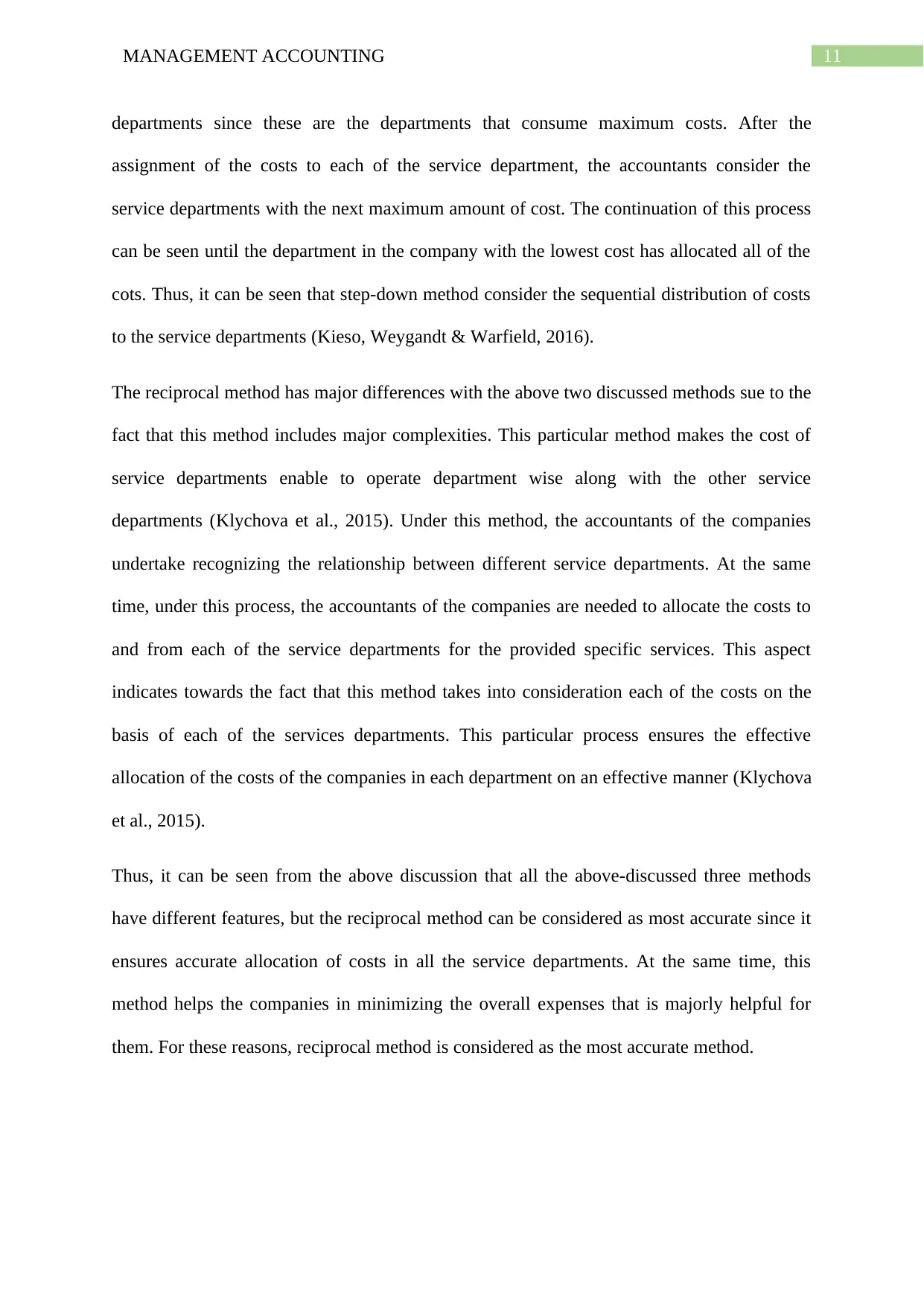
11MANAGEMENT ACCOUNTING
departments since these are the departments that consume maximum costs. After the
assignment of the costs to each of the service department, the accountants consider the
service departments with the next maximum amount of cost. The continuation of this process
can be seen until the department in the company with the lowest cost has allocated all of the
cots. Thus, it can be seen that step-down method consider the sequential distribution of costs
to the service departments (Kieso, Weygandt & Warfield, 2016).
The reciprocal method has major differences with the above two discussed methods sue to the
fact that this method includes major complexities. This particular method makes the cost of
service departments enable to operate department wise along with the other service
departments (Klychova et al., 2015). Under this method, the accountants of the companies
undertake recognizing the relationship between different service departments. At the same
time, under this process, the accountants of the companies are needed to allocate the costs to
and from each of the service departments for the provided specific services. This aspect
indicates towards the fact that this method takes into consideration each of the costs on the
basis of each of the services departments. This particular process ensures the effective
allocation of the costs of the companies in each department on an effective manner (Klychova
et al., 2015).
Thus, it can be seen from the above discussion that all the above-discussed three methods
have different features, but the reciprocal method can be considered as most accurate since it
ensures accurate allocation of costs in all the service departments. At the same time, this
method helps the companies in minimizing the overall expenses that is majorly helpful for
them. For these reasons, reciprocal method is considered as the most accurate method.
departments since these are the departments that consume maximum costs. After the
assignment of the costs to each of the service department, the accountants consider the
service departments with the next maximum amount of cost. The continuation of this process
can be seen until the department in the company with the lowest cost has allocated all of the
cots. Thus, it can be seen that step-down method consider the sequential distribution of costs
to the service departments (Kieso, Weygandt & Warfield, 2016).
The reciprocal method has major differences with the above two discussed methods sue to the
fact that this method includes major complexities. This particular method makes the cost of
service departments enable to operate department wise along with the other service
departments (Klychova et al., 2015). Under this method, the accountants of the companies
undertake recognizing the relationship between different service departments. At the same
time, under this process, the accountants of the companies are needed to allocate the costs to
and from each of the service departments for the provided specific services. This aspect
indicates towards the fact that this method takes into consideration each of the costs on the
basis of each of the services departments. This particular process ensures the effective
allocation of the costs of the companies in each department on an effective manner (Klychova
et al., 2015).
Thus, it can be seen from the above discussion that all the above-discussed three methods
have different features, but the reciprocal method can be considered as most accurate since it
ensures accurate allocation of costs in all the service departments. At the same time, this
method helps the companies in minimizing the overall expenses that is majorly helpful for
them. For these reasons, reciprocal method is considered as the most accurate method.
⊘ This is a preview!⊘
Do you want full access?
Subscribe today to unlock all pages.

Trusted by 1+ million students worldwide
1 out of 15
Related Documents
Your All-in-One AI-Powered Toolkit for Academic Success.
+13062052269
info@desklib.com
Available 24*7 on WhatsApp / Email
![[object Object]](/_next/static/media/star-bottom.7253800d.svg)
Unlock your academic potential
Copyright © 2020–2025 A2Z Services. All Rights Reserved. Developed and managed by ZUCOL.





